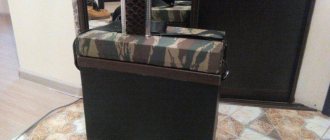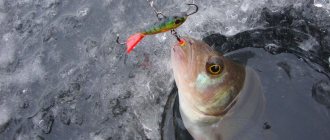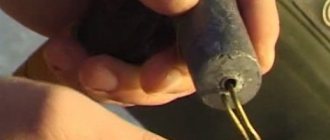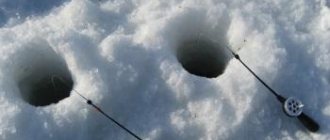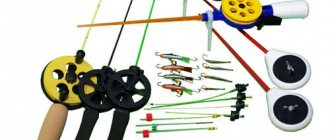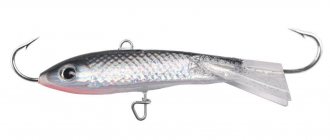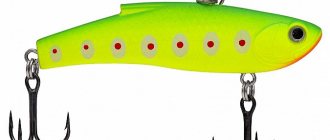Under the topic title “Homemade balancer for winter and summer fishing” I will describe my horizontal winter lures, which I have been making for decades.
For some reason, fishermen have developed the habit of considering homemade or purchased balancers of any design as winter baits, implying that fishing with horizontal spoons can only be done when fishing from ice.
I will try to prove that this is not so. In the summer season, a homemade balancer has even more possibilities than during winter fishing.
Especially if the bait is made with your own hands specifically for a specific game - fishing in some summer reservoir chosen for fishing, studied by the fisherman.
Below in the text I will explain why homemade balancers, made with your own hands for playing in a limited column of water, are much more promising for summer fishing, although the vast majority of fishermen catch predatory fish with horizontal spoons using winter fishing rods from the thickness of the ice.
Homemade balancer for winter fishing
The capabilities of balancers during winter fishing, in contrast to fishing with the same horizontal baits in open water in the summer, can be very limited. Moreover, the restrictions are not at all related to the cleanliness of the reservoir.
By the middle of winter, the increasing thickness of ice on reservoirs begins to interfere with the sweeping movements of balancers during winter fishing. It is this factor that begins to affect the possibilities of posting a horizontal spinner of any design.
And the lower the depth chosen for catching predatory fish in winter fishing, the greater the distortion of the balancer wiring can be, which probably not every novice fisherman has thought about.
Next, those interested can take a closer look at the very essence of the issue related to the possibilities of playing a homemade balancer while fishing in winter and compare it with the capabilities of a horizontal bait in summer fishing.
Homemade ice fishing game
To explain the game of any homemade or purchased balancer during winter fishing, I drew a drawing that schematically shows two complete trajectories of the same balancer at different fishing depths.
Two green rays show the sector of the game of the balancer in winter fishing when fishing at relatively great depths.
The letter “G” indicates the depth of the game, where there is no failure in the balancer wiring yet. But the length of the bait’s planning trajectory should not exceed that shown by the scarlet arc under the number “2”.
But we should obviously be wary of failures in the balancer at shallower depths with a fairly noticeable ice thickness, if we take into account the winter fishing conditions shown in my drawing.
Such distortions in the game of balancers can only happen during winter fishing. An example of the trajectory of a horizontal bait in the shallows is shown by an arc under the number “1” and its two continuations in the form of black arrows.
As can be seen from the figure, the quality of the balancer's play in winter fishing conditions depends on at least two factors: the diameter of the hole and the thickness of the ice.
The larger the diameter of the hole and the thinner the ice, the longer you can set the amplitude of the throw to the balancer without the risk of distortion during the play of a homemade bait - with complete freedom for a horizontal spoon when fishing in the summer.
Obviously, this concept can only be changed by playing a homemade balancer on ice fishing within a circle of adjustable diameter. Based on these considerations, the designs of my homemade balancers were invented and then manufactured.
To demonstrate the capabilities of horizontal spinners for winter or summer fishing, three videos showing the game of homemade balancers of three different designs are embedded in the page.
Fishing with a balance beam during winter fishing
Most of us fish on winter fishing trips with balance beams, placing the rod of the rod near the hole, thereby somewhat compensating for the height of the glass of ice.
If you fish with a high winter fishing rod, then the conditions for playing balancers without distortion will be much worse, as we were convinced of after reading the evidence in the previous article.
It turns out that as the ice thickness increases, fishing with a balancer should shift to greater depths.
But here the prospects for catching predatory fish with a balance beam will begin to have a noticeable influence on a completely different factor, inherent in both winter and summer fishing.
As the fishing depth increases, the range of oscillations and the speed at which the balancer is pulled will be increasingly reduced by the long fishing line trailing behind the balancer.
So is it any wonder that when catching fish in winter fishing from thick ice, any vaunted balancer can be given a head start by a homemade sheer gliding spoon, where the fishing line cuts through the water not so much with its side surface as with its transverse thin section?
This introduction had to be printed only because all the homemade balancers of my designs, compared to purchased ones, feel much more comfortable during winter fishing, because in addition to playing in the form of straight throws, they also have circular wiring with adjustable radii of the circles.
You will be convinced of the correctness of my words by watching videos on this page of the game of homemade balancers of various designs.
First, check out the capabilities of the mini balancer - my smallest horizontal homemade spoon, which was made in winter. Then tested in the process of catching perch during summer fishing.
A few words about the place
As you know, the wolf is fed by his legs, and, by the way, so is the fisherman. Getting a decent catch from 1-2 holes is very rare. An experienced fisherman never sits still until he finds a school. It’s quite common to drill fifty holes and pull out two fish, but on the second one you can sit tightly in place and drag the perch one after another. It depends on how lucky you are.
Read How to catch roach in autumn and choose working baits
After you have drilled a hole, let it “breathe” for a few minutes so that the fish calms down. If there is no bite, don’t stay too long, move on. The perch stays in groups and reacts at a distance of about 3 m around itself, so you should not drill closer than 5 m from a ready-made hole.
Fishing technique
Observing experienced fishermen, you will notice that no one waves their fishing rod with the monotony of a metronome.
Fishing with a balance beam is a creative process. Please note that the perch is not stupid and will not rush at the first movement, especially in winter. The fish need to be interested, played, and then the catch is guaranteed. First of all, you need to find the bottom. Remember that small balancers (up to 2.5 g) are effective at a depth of up to 3 m, otherwise heavier baits should be used. Then you need to move the bait up about 20 cm and lightly play with the brush. You should not make sudden and rough movements - this can weaken the fish’s interest, and besides, the perch also attacks the bait slowly. So gradually move the balancer higher, periodically simulating sluggish jumps, until you have fished the hole to its full depth.
Try to follow the slightest blow and continue playing at the mark where the fish showed interest in your bait.
Over time, you will be able to make adjustments to your technique from personal experience.
Homemade mini balancer for fishing
Homemade mini balancers for catching perch during winter fishing are shown in the picture.
The technical process for making miniature horizontal baits from scratch with your own hands is in the topic called Homemade balancer for perch. There, interested fishermen can learn how to make a simple punch and matrix for soldering jigs and mini-balancers.
I started catching perch with homemade mini-balancers about 40 years ago. And I still carry horizontal baits in sets of vertical perch spoons on my summer and winter fishing trips.
Homemade mini-balancers are quite promising baits when catching perch in shallow water immediately after freeze-up, that is, from the very first ice. For summer fishing with the same baits, it is advisable to increase the weight (size) of the balancers.
In the article “Balancer - Dolphin” we bring to your attention another homemade horizontal mini bait, similar to the previous one, for catching perch in winter and summer fishing.
The external difference between the two horizontal mini-spoon baits lies not only in the method of suspension to the tackle, but in the absence of a hook at the head end of this homemade balancer.
Similar mini-balancers were tested on summer fishing trips much later than our own. And on these homemade horizontal baits, in addition to perch, fish from the carp family often sit. (If you tie a hook with a bloodworm attachment to the tail of the balancer on a leash.)
Both modifications of mini-balancers are promising for winter fishing on the first ice when catching predatory fish in shallow areas of reservoirs without a noticeable current, where perch often feeds at the beginning of winter.
Refinement of the balancer
Fishing with a homemade balancer, as sometimes with factory versions, is not always successful due to the presence of minor defects in the game, an imbalance in the mass of additional elements and the body of the bait, as well as the asymmetry of the wings. Having identified these inconsistencies, the fisherman can easily improve the design flaws by grinding sagging and poor-quality surfaces, leveling the wings by symmetrically trimming them, balancing with the help of additional weights, bending the fastening loop, and also changing the tee to a smaller or larger form.
In some cases, you can resort to repainting the entire body of the balancer or adding brighter and more contrasting colors to its colors. All these seeming little things can turn a previously unpromising fishing tool that has been lying around for years as an extra in the fishing arsenal into a leading bait capable of stable performance in the results of its catches.
Read Fishing for crucian carp on a nipple
Fishing with a homemade balancer in summer
The places for catching perch and other fish during summer fishing with any balance beam would be no different from winter ones, if not for two factors that directly affect the final result of the catch.
Taking into account the direct dependence of the trajectory of the game - guiding the balancer on the length of the descent of the fishing line, which for the summer has to be set to a larger diameter, fishing with a balancer in open water shifts to higher levels in relation to the horizons of winter fishing. That is, broke.
The second factor that adversely affects the prospects of summer fishing with a homemade or purchased balancer follows from the first - this is the unmasking of the fisherman when catching predatory fish in shallow areas of the reservoir.
Both problems are solved by a long rod with a rigid action, although we are unlikely to be able to control it comfortably. In addition, then another problem will arise associated with removing the caught fish from the balancer hook, hanging somewhere under the clouds at the level of hooking a long telescope.
It turns out that to catch fish on a summer fishing trip with a balance beam, it is advisable to use a rod that is not too long, with which the fisherman can set the necessary game for the balance rod, but then some kind of screen will need to be installed between the fisherman and the fish.
On this occasion, I drew a picture where I tried to depict all the obstacles that arise when fishing with a balance beam during summer fishing and the methods that allow you to bypass or smooth out these obstacles.
Although, to be honest, I myself rarely catch fish with a balance beam during summer fishing, and then only during the evening rutting season with perch in shallow fry. It happens that you run into a school of pike perch, but then it happens that you have to say goodbye to your homemade balance beam.
I will list the conditions that, in my opinion, are suitable for fishing with a self-made balancer during summer fishing from a small boat:
A rigid (fast) action rod with a length of no more than 4 meters is required. In the old fashioned way, for these purposes I use plug-in bamboo fishing rods, familiar since Soviet times, with the simplest lightweight equipment and a nod made of a clock spring 10-12 centimeters long. The thickness of the fishing line on summer gear is 0.14-0.15 mm.
In order to make your hand less tired during fishing in the summer, I place a backpack between the seat and the stern side of the rubber boat, which serves as a support for the butt of the fishing rod. As a result, when controlling a homemade balancer, a lever of considerable length appears.
The best places for summer fishing for perch with a homemade balance beam are windows among the algae. I position the boat so that the shadow of a small boat at the bottom of the reservoir does not loom in front of the nose of perch and other fish.
Although, during the rutting season, the perch in the shallows loses all caution and you can successfully catch the red-finned predator during summer fishing right next to the boat.
How to make a balancer at home
There are a number of methods for making horizontal spinners at home, radically different from each other in their solutions. For example, the easiest option to make a balancer would be to process a metal rod or hexagon into the desired shape, followed by soldering fasteners and hooks. But such hunting instruments have a high mass and are quite difficult to adjust to the optimal rhythms of the game.
The best option for producing a homemade product is considered to be casting it from lead, tin, copper and its alloys . The resulting balancers have the qualities of stable and even play, have a weight that is harmonious for their size, and are also easy to adjust. The casting method is more labor-intensive and time-consuming, which is inferior to the processing of metal profiles, but the final result of the product pays for all these negative aspects, in addition, a well-made matrix contributes to the mass production of homemade products, which reduces the cost of the product without any impact on its performance characteristics .
Homemade bladeless balancer for fishing
The topic Bladeless Balancer for Fishing provides a description of my homemade horizontal baits, which are successfully used more in winter than in summer fishing.
In terms of how labor-intensive it is to make with your own hands, these are the simplest balancers, which are soldered using the same technology as vertically gliding boat-shaped spoons.
The trajectories of circular and straight lines of homemade bladeless balancers in fishing conditions can be assessed by watching a short video.
Video - Bladeless balancer for ice fishing
The video shows techniques for accelerating homemade bladeless balancers in a horizontal plane along a broken circle and throwing baits that imitate the behavior of small fish in winter or summer fishing conditions.
In the photo on the left you see these same homemade bladeless balancers, which I managed to place on the side ribs (glued to paper).
Immediately after testing for professional aptitude in the bathroom, the homemade jigs, spinners and balancers participating in the filming of the video are photographed for placement on the pages of the site (until the polish fades).
Poorly made baits are usually corrected. Therefore, there are practically no defects when making one or another bait with your own hands.
After that, homemade bladeless balancers are used in fishing conditions, if not by ourselves, then by some of my friends, a couple of whom give me a lift in their jeeps to the winter fishing spot.
Homemade fishing balancer with side rudders
In the articles under the topic heading Balancer for fishing with side blades, a description is given of homemade spinners with a horizontal suspension to the tackle with side rudders soldered into the body of the bait.
Homemade balancers of this design are suitable for winter and summer fishing and have one feature.
During the manufacturing process with your own hands, side rudders in the form of blades are soldered into the bodies of the balancers, by changing the bend of which you can directly change the play characteristics of horizontal baits while fishing.
Video - Balancer with side rudders in fishing conditions
I will explain in words some of the video plots that you may find useful when fishing with balance beams with side rudders in real conditions of summer or winter fishing.
Stabilization of both straight and circular movements when playing a balancer is carried out due to artificial attachments on the tail hooks, that is, exactly the same as with a homemade bladeless balancer.
If you have already appreciated the game of balancers in the video, you might have noticed the sweeping motion of horizontal baits with side rudders - blades, both when accelerating in a circle and when throwing to the sides. And this is with a very short descent from the winter fishing line.
Homemade balancers with side rudders are heavier than the bladeless horizontal baits disassembled above (due to the greater mass in the metal structures). Therefore, when fishing with such balancers, you can catch fish at greater depths.
Materials and tools for making a balancer
We will make balancers from soft lead in an alabaster mold. We will also need steel wire 0.3 mm thick and copper wire of the same thickness. We also need red plastic in the form of a sheet. We will cut out the blades for the tail section from it.
You can paint the balancers with aerosol or acrylic paints. They dry quickly and do not leave a strong odor. We use hardened tees and hooks with a long shank. We select the sizes of hooks to match the size of the bait. We will also need glue with which we will glue the blades to the body of the bait. From the tools we will need a knife, wire cutters, pliers, ducks, a paint brush, a tin can, a gas burner, a small block, needle files and fine sandpaper.
[custom_ads_shortcode3]
Homemade balancer with a tail blade
Making your own balancers of this design is discussed in detail in the topic Homemade balancer with a tail blade.
The tail wing serves here as an element that, to some extent, regulates the trajectories of the balancer during summer or winter fishing.
An artificial attachment on the tail hook stabilizes the wiring of homemade spinners with a horizontal suspension to the tackle in the same way as the balancers of the two previous designs used in winter and summer fishing.
The hook is soldered in a hinged mounting version above the tail blade of the balancer.
Video - Game of balancer with tail blade
A homemade balancer with a tail blade has wiring that “wiggles” somewhat in the horizontal plane, as you can see when watching the video. A small fish behaves in approximately the same way when escaping the jaws of a voracious perch.
The design of homemade balancers with side blades allows baits, in real conditions of summer or winter fishing, to also reproduce two types of movements: in the form of leaving a state of rest to the side and accelerating in a circle.
True, the process of making these balancers with your own hands is somewhat more complicated and takes longer in terms of time spent than soldering all my other homemade horizontal baits.
Therefore, it is quite irrational and wasteful to leave such balancers with “dead” holds on winter snags and in thickets of summer algae. And such hooks happen both during winter and summer fishing.
To help you, I recommend making a detachment with your own hands, the first of which was once made specifically to save your homemade sophisticated balancers during summer and winter fishing.
***
